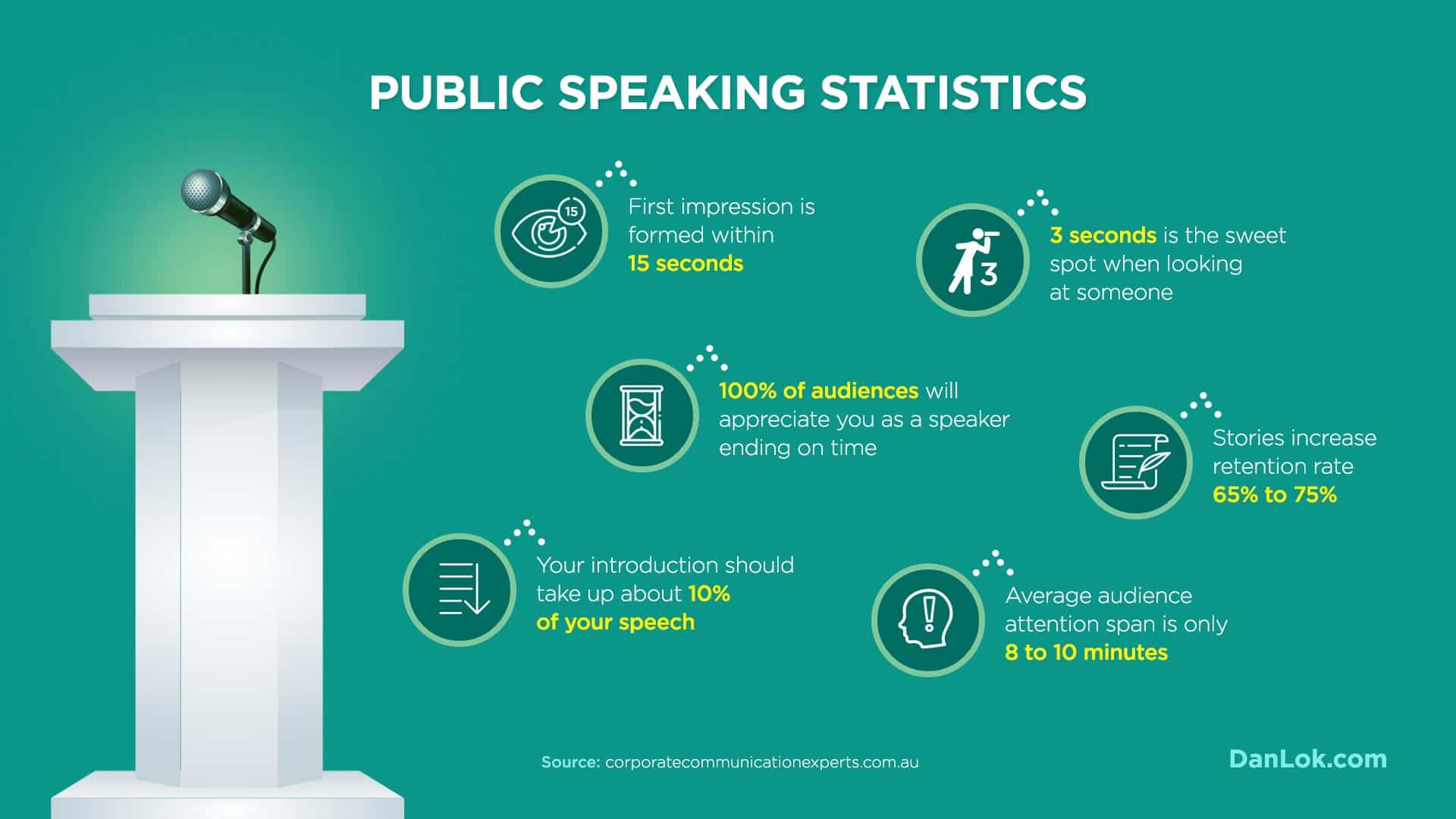I’ve had the privilege of giving not one, but two TED talks. One is called The Invisible Force, a talk about self image. The other is The Real Difference Between Success and Failure, a motivational speech I gave at SFU, a prestigious local university.
If you’ve been nominated to speak at a TED talks event, what do you do to prepare for it, from working on your speech to the final moments before getting onstage? How do you deliver a rousing speech that moves thousands of people if your greatest nightmare is public speaking? What if you want to rise to the level of confidence and leadership of CEOs, presidents, entrepreneurs, and valedictorians when you speak… but you become tongue-tied when you’re asked a question?
It can happen to anyone. Losing your voice when you wanted to propose. Or breaking out in a sweat when you were presenting an idea at work. Fear of public speaking can become an inconvenient wall that gets thrown in your way.
Approximately 25 percent of people say they experience glossophobia – fear of public speaking – at some point in their lives. But consider the impact this fear can have on a person’s lifetime success with these statistics:
- 10% impairment on college graduation
- 10% impairment on wages
- 15% impairment on promotion to management
That means if your income is $50,000 a year, for example, then an inability to present your ideas at work or communicate clearly in general would reduce your income to $45,000. That’s a difference of $5000. Over a lifetime of shyness, those losses will add up, especially if you’re looking for a promotion.
If overcoming fears of public speaking can significantly change our level of achievement in life, what can we do to start building our confidence?
Most people aren’t born with the ability to deliver polished speeches and presentations. Instead, they make a conscious effort to improve their public speaking skills. A popular method is by joining Toastmasters.
How Toastmasters Improves Public Speaking And Leadership
Joining Toastmasters was a pivotal point in my professional career. I’ve come a long way from hiding in the school bathroom to where I am now. Back then, I couldn’t have taught an all day training in a room packed with a thousand people. I couldn’t have done a TED Talks either.
Back then, my high school teacher gave me an ultimatum: do a speech in front of the class for an assignment, or fail English. I was so overcome by fear, I ran and hid in the bathroom. It was a terrible time in my youth, when I didn’t have friends and I was struggling to speak in English, my second language.
Stronger Public Speaking Skills
I survived that high school speech, and I was introduced to Toastmasters. Their mission is to teach people to become confident communicators. Famous people who have taken their careers to a whole new level and joined Toastmasters include author Napoleon Hill, actor Leonard Nimoy, international consultant Anita Perez Ferguson, athlete Steve Fraser, and astronaut James Lovell.
Toastmasters has locations around the world. At these meetings, you learn how to give different types of speeches, from informative to persuasive, and you learn public speaking tips. For the ultra ambitious, you can compete in local, regional, and worldwide speech competitions.
Imagine reaching that level of competence, when you can give a speech in front of thousands, while the clock is ticking, and judges are taking notes. How would that affect your confidence level if you can remain calm under stress?
Stronger Leadership Skills
The confidence you learn as a presenter transfers to your assertiveness as a leader. Toastmasters teaches public speaking and leadership together because your ability to excel at one is strongly connected to your ability for the other.
According to research, “what you say to an audience isn’t nearly as important as how you say it. Studies suggest that effective presentations are 38% your voice, 55% non-verbal communication, and only 7% your content.” Share on X
Your body language (non-verbal communication) and the tone of your voice have more impact on your listeners than your actual words. Just think about the self assurance and coolheadedness that strong leaders possess. When they speak, people listen, because their posture conveys that authority. They can clearly get their point across to their audience and they can articulate their goals.
Even if you aren’t interested in leadership, strong speaking skills are handy if you want to be an entrepreneur or freelancer. You can communicate to your customers or clients why they should do business with you.
Speaking like a leader has other advantages:
- You don’t shy away or “pull back” when you’re making a point about a difficult topic. You don’t say, “This is kind of a tough situation.” The CEO doesn’t “kind of” think they should fire lazy workers. And you don’t “sort of” want an employer to pay you more. State exactly what you want.
- You’re always aware of your voice and speech. Some people have a habit of “uptalk” – speaking with a rising vocal inflection at the end of sentences so it sounds like you are always asking questions. The overall impression is you sound unsure of yourself if you use uptalk on a regular basis.
- You use the word “but” very carefully because you want to be positive. When a leader says, “Thanks for the feedback, but I think…”, it sounds like the leader doesn’t appreciate the feedback and thinks their opinion is more important. Compare that with “I’ve considered your feedback and still believe in my decision.” The “and” suggests equal weight to both the other person’s feedback and their own feedback.
This level of awareness of your choice of words takes time, especially if you get nervous when speaking in front of others. The only way to really perfect your speaking skills is to practice giving more speeches, even if you feel you’re getting better at doing them.
Dale Carnegie once said,“There are always three speeches, for every one you actually gave. The one you practiced, the one you gave, and the one you wish you gave.” Share on X10 Tips On How To Deliver Your Dream Speech
“People don’t buy what you do. People buy why you do it.” – Simon Sinek
Speech making is a skill you develop, just like exercising regularly to become more fit. Whether you’re pretty confident about your presentation abilities or you’re working at reducing the fear, these 10 tips are the ingredients for a killer presentation.

Tip 1: Outline
A speech must have structure. What is the key theme or idea for your speech? What are the main ideas? You have the first 30 seconds to grab the attention of your audience and keep it. And this is after you’ve passed the first hurdle: people form a first impression about you within 15 seconds.
To capture their attention, decide on a clear goal for your presentation. For example, you’re speaking about growing sales teams for small businesses. One recommendation is to “Start by nailing down your objective. If it’s getting the audience to hire you as a sales consultant, build your speaking topic around five things preventing small sales organizations from scaling.”
Tip 2: Practice Public Speaking
If you feel nervous about presenting in front of people, preparing and practicing will help with your anxiety. Review your notes and learn your points by heart so you won’t have to read. During your speech, maintaining eye contact is important for building a connection.
Practice your speech in front of a small but critical crowd. If they are your friends, ask them for honest feedback, even if it’s harsh. Better to know early on and not when you’re speaking to hundreds of people.
Another option is to videotape yourself speaking. If you think you sound strange, it’s normal. Everyone sounds different than they expected.
To add an extra level of difficulty, practice with distractions. Turn on the TV. Cook a meal. Run on the treadmill. If you can rehearse your speech smoothly despite these distractions, you know your speech well.
Tip 3: Tell a story
Each presentation tells a story with a beginning, middle, and end. Stories connect with your audience, stir up emotions, and provide a personal touch.
Maya Angelou once said, “People will forget what you said, people will forget what you did, but people will never forget how you made them feel.”
You can start your presentation with a thought-provoking statistic, quotation, or anecdote and end your presentation with a summary and a memorable statement. Another option is to share one surprising, random fact that no one knows.
Tip 4: Keep it simple
Keep your message simple and digestible. People generally only remember 3 main ideas about any presentation after they’ve seen it.
To increase how much your audience will remember, use facts and figures during your speech. But present those numbers in a way that’s engaging and compelling. If you present them well, audience retention increases by 20 percent.
Also, give value to your audience with fresh new insights and strategies. Teach them or inspire them, but don’t come across like your main goal is to pitch them your product or service.
Renowned speaker Simon Sinek commented, “We are highly social animals. Even at a distance onstage, we can tell if you’re a giver or a taker, and people are more likely to trust a giver — a speaker that gives them value, that teaches them something new, that inspires them — than a taker.”
Tip 5: Audience
Learn as much as you can about your audience before the date of your presentation. What you know about them will help you decide on your choice of words and how you motivate them.
If possible, meet with audience members before your speech. Later, you will have some friendly faces to focus on if you’re nervous. As an added bonus, you will be able to share anecdotes that are more relevant to your audience because you took the time to know them more personally.
Some of the questions you want to answer about your audience are:
- How many people will be in the audience?
- Who is speaking before/after me and on which topics?
- Is there a theme for the event?
- What level will the audience be in terms of knowledge/experience?
- What do you think they’d want to hear about?
If your speech isn’t about a topic that will interest your listeners, then you are wasting their time and yours.
Tip 6: Body language
Non-verbal communication is stronger than verbal, so if you look nervous, that message will be louder and stronger than anything you say. No matter how nervous you feel, project confidence and own the room during your time on stage.
Rob Gilbert advises, take control of your situation. “It’s alright to have butterflies in your stomach. Just get them to fly in formation.” Share on XTip 7: Visuals
Visuals like photos, diagrams, and videos enhance your presentation and bring your key points to life. If possible, put fewer words on the screen and memorize the ideas so you’re doing the majority of the explaining.
The American Speech-Language-Hearing Association recommends formatting your slides in this way:
- Use keywords instead of sentences or paragraphs
- Bullet your body copy, using punctuation sparingly
- Never use more than eight words per line or eight lines per slide
When optimizing your font for your audience, keep these numbers in mind:
- Make your font size double the average age of your audience
- Use font between 60 and 80 points for your presentations
When working with technology, you should also create contingency plans. What if your slides fail? What if your projector fails? Have a backup plan so your presentation will flow smoothly even without the visuals.
Tip 8: Personality
Monotony kills speeches. Develop an onstage personality, especially if you don’t have much vocal variety when you normally speak. The second your audience becomes bored, the mobile phones come out to entertain your listeners.
Do something that will make you memorable. Tell a joke if you are good at this and you have a good read on the audience. Otherwise, worst case scenario, your joke could bomb or offend.
Becoming memorable can be as simple as a small detail. I have my trademark red suit.
If your personality shines through and your audience sees you as a real person, you will have an easier time gaining their trust.
Tip 9: Timing and Ending The Presentation
They say, “tell us what you’re going to tell us, tell us, and then tell us what you told us.” Repeat your main message throughout your speech, and especially at the end.
Slow down your speech to emphasize main points. One effective technique is to pause. A TED Talks recommendation is to adjust your pause length. “Pause for two or three seconds and audiences assume you’ve lost your place; five seconds, they think the pause is intentional; after 10 seconds even the people texting can’t help looking up.”
Finally, your audience and the next presenter will love you if you finish on time or early. So when you practice your speech, time it so you end one minute before your allotted time. For example, finish in 5 minutes if you have 6 minutes to speak.
Tip 10: Feedback
Always watch your audience during your presentation. How are they reacting to what you say? Are they excited? Should you move on from a making a point if they’re bored? Adjust your presentation to keep them interested.
If they have a question, answer it. Their questions show they are engaged. As a presenter, you may feel nervous about giving the audience such control. What if they ask something you can’t answer?
However, the other way to look at it is this: your audience wants to know more because you’ve said something that resonates with them. More importantly, interaction with the audience is the mark of an experienced speaker. So if they ask a question, stop and answer it.
Advanced level speakers like the ones who speak at TED are brilliant storytellers who can capture the audience’s attention and maintain it until the end.
How You Can Learn Public Speaking From The Talented Speakers At TED Talks
If Toastmasters is where you train to become a great speaker and leader, TED Talks is where you share your message when you’ve become a confident and talented speaker, ready for the world stage.
It’s a global community where people speak on topics from science to business to global issues… in more than 100 languages. Collectively, TED Talks speakers have won every major prize awarded for excellence, including the Nobel, Pritzker, Fields, Pulitzer, Oscar, Grammy, Emmy, Tony and MacArthur “genius” grant.
To speak at TEDx, you can nominate yourself or nominate someone else. TED also seeks out emerging artists, scientists and thinkers, and introduces them to the TED community before they hit the mainstream.
Talks are about 18 minutes long and have even featured speakers under the age of 20. Topics from young speakers and talks from the top 10 most watched discuss themes like community, solutions to problems, motivation, and new perspectives. For example:
- “How I harnessed the wind” – William Kamkwamba at the age of 22 shared his story about how he saved his home at the age of 14 by building a windmill
- “Yup, I built a nuclear fusion reactor” – Taylor Wilson at the age of 17 gave a talk about a solution to our future energy needs
- “How great leaders inspire action” – Simon Sinek gave a presentation about inspirational leadership
- “Looks aren’t everything. Believe me, I’m a model” – Cameron Russell presented a speech about the genetic lottery
How To Prepare To Speak At TED Talks
Time goes by so fast when you’re onstage, connecting with the audience. But before you get there, you need to do a lot of preparation. You need to commit your speech to muscle memory. Here are some points to follow for your TED talks:
- Set aside 1 hour of preparation for 1 minute onstage. I set aside 100 hours to prepare a 20 minute speech. (TED speeches are 18 minutes long)
- Your preparation time includes script writing, PowerPoint slides, and speech rehearsal.
- Write the script, get feedback, and revise again and again.
- Remember your mission and why you’re giving this speech. For me it was impacting a million people. Always check back at each revision and ask yourself if your speech is fulfilling your mission.
- The day of your speech, do an activity that will get you into the right mindset. I listen to my Attitude of Gratitude audio.
- Visualize where you will be giving your speech. Depending on how big the room is, I try my best to mentally touch each chair as if I’m connecting with each person who will be in the audience.
- Do a power move before going on stage. The power move will elevate your energy. For example, I might be at a 3 or 4 energy level, then I do my power move, and BOOM, I’m at a 10 before I go on stage.
Watch this video that takes you behind the scenes of a TEDx speaker.
Author and reporter David Epstein said that speaking at TED Talks “forced me to be really sharp with my transitions, and to pick examples that I could explain really succinctly, even if they were not the simplest ideas in the world. With that amount of time, you know you can only make so many points, so you’re forced to make them count.”
Summary
Public speaking is a valuable skill that helps with career and school advancement. Many people are afraid of giving speeches or talking in public, and that fear can hold them back in their professional and personal life.
To improve your presentation skills, practice consistently. Use strategies such as storytelling and visuals to keep your audience interested in what you have to say. Learn as much as you can about your audience before your presentation, and get feedback from them during your presentation to make your speech more engaging.
Joining an organization like Toastmasters can help to improve your speaking skills. If you want to learn from some of the best presenters, watch TED Talks for examples of some of the best storytelling.
“Speech is power. Speech is to persuade, to convert, to compel. It is to bring another out of his bad sense into your good sense.” – Ralph Waldo Emerson Share on XHow To Influence People
- To influence an audience to support your idea, purchase your product/service, or fund your business, you need to master your leadership skills, vocal tonality, and ability to read people.
- In this 4-day training, you will learn how to leverage the power of the 4 GEM personality theory to influence others and get more of what you want. Click here to learn more.




